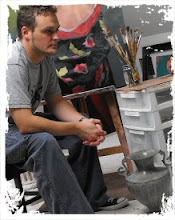Billy Seccombe
www.billyseccombe.om
https://twitter.com/wseccombe
The first image includes Nelson's palette. On a previous entry to my blog I had outlined the colors and particular brands of paint used so I won't get into that now. You will notice that the only two mediums used here were Turpentine and Stand Oil. The Stand Oil was cut with Turpentine which appear in two small tins to the right.
 Secondly, he began on a medium gray toned canvas where he sketched out large forms much in the way that a sculptor would approach a block of marble. He looked for large geometric forms and an inner harmony among all the shapes in the composition. Many of the strokes continued beyond the figure which he then used to draw relationships to all of the parts as a whole. This is the main approach to Shank's teaching and he continually reinforces this principle throughout the class. This concept is also taught by Dan Thompson at the New York Academy of Art.
Secondly, he began on a medium gray toned canvas where he sketched out large forms much in the way that a sculptor would approach a block of marble. He looked for large geometric forms and an inner harmony among all the shapes in the composition. Many of the strokes continued beyond the figure which he then used to draw relationships to all of the parts as a whole. This is the main approach to Shank's teaching and he continually reinforces this principle throughout the class. This concept is also taught by Dan Thompson at the New York Academy of Art.
 After the initial search lines were established he began to break down the figure into highlight and shadow forms not to get caught up in small details.
After the initial search lines were established he began to break down the figure into highlight and shadow forms not to get caught up in small details. At this point, highlights were filled in with a warm yellow-orange flesh tone. There is no pre-mixing of flesh tones but rather mixing as he needs it to give more of an immediate impression upon the colors observed.
At this point, highlights were filled in with a warm yellow-orange flesh tone. There is no pre-mixing of flesh tones but rather mixing as he needs it to give more of an immediate impression upon the colors observed. As the painting developed he continued to add various mid tones and other colors such as pinks into the nose and lip areas and followed that with the addition of the shadow colors in the hair and along the neck. His shadows were achieved by scumbling purple into the brown underpainting. Shanks is constantly moving his arm in rather large gestural motions as he sculpts out the form. This lends itself well to capturing a sense of energy and movement in his work. He is always stands at an arms length distance from the canvas even when painting the smallest of details.
As the painting developed he continued to add various mid tones and other colors such as pinks into the nose and lip areas and followed that with the addition of the shadow colors in the hair and along the neck. His shadows were achieved by scumbling purple into the brown underpainting. Shanks is constantly moving his arm in rather large gestural motions as he sculpts out the form. This lends itself well to capturing a sense of energy and movement in his work. He is always stands at an arms length distance from the canvas even when painting the smallest of details.

At this stage we took a short intermission and we had a chance to take an up-close look at what would be considered a half-way point.


Shanks continued to refine the values and colors established in the first session of painting.
 The final image took roughly 2 hours from beginning to end. His portraits have a rather rich quality to them. His paintings tend to be very saturated and small areas may consist of a variety of colors. I would also mention that at the final stage he uses a large 4" brush and gentle glides the bristles across the surface in different directions to smooth out some of the planes. This gives the whole painting a very softened and unified feeling.
The final image took roughly 2 hours from beginning to end. His portraits have a rather rich quality to them. His paintings tend to be very saturated and small areas may consist of a variety of colors. I would also mention that at the final stage he uses a large 4" brush and gentle glides the bristles across the surface in different directions to smooth out some of the planes. This gives the whole painting a very softened and unified feeling.-William Seccombe
www.williamseccombe.com





That is terrific! Thanks for that!
ReplyDeleteI've been dying to see one of his demonstrations for a long time. Truly a modern master.
Thanks for sharing. I find it interesting that even detail can be achieved from an arms length away.
ReplyDelete